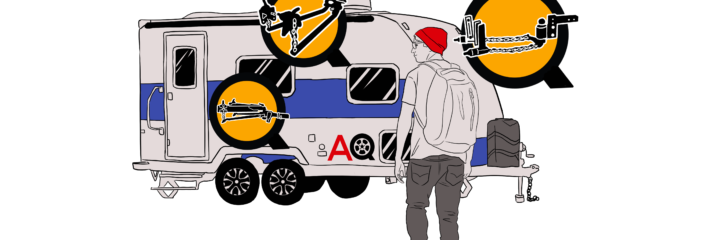Have you ever been driving down the road and seen someone towing a trailer with their tailgate nearly dragging on the ground and the headlights pointed at the sky? Have you been that person? Not only is this dangerous because a hitch dragging on the ground can start fires, but it dramatically reduces the effectiveness of your vehicle’s brakes if its front wheels aren’t making full contact with the ground.
A weight distribution hitch can significantly mitigate that danger, and the good news is that they are easy to find, buy, and install.
- An Introduction to Weight Distribution Hitches
- Top 8 Best Weight Distribution Hitches 2026
- 1. Best Overall Pick: Husky Center Line
- 2. Best Budget Pick: EAZ Lift Elite Kit
- 3. Best Premium Pick: Andersen Hitches No-Sway Hitch
- 4. Best For Heavy Trailers: Curt Short Trunnion With Sway Control
- 5. Easiest to Install: Curt MV Round Bar With Sway Control
- 6. Best Sway Control: Reese Strait-Line
- 7. Most Versatile: Fastway e2
- 8. Best Basic Weight Distribution Hitch: Reese Wd Rb Pro
- In-Depth Guide on Weight Distribution Hitches
- Enjoy the Journey
An Introduction to Weight Distribution Hitches
The average person who tows a trailer probably hasn’t heard of a weight distribution hitch. That’s a shame because they can improve safety and drivability in many situations. In this article, we want to tell you about what they are. We also want to set you on the right path towards buying your own with product reviews.
What Do They Do?
In order to make a very technical story short, a weight distribution hitch works by using torque to level a vehicle that is towing a trailer. If you’d really like to know the physics behind it, this angry Australian man does a great job explaining it.
When you apply a load to the back of a vehicle, it will raise the front and lower the back. Just go stand on the back of a small car if you don’t believe us. For many vehicles, a heavy trailer is more than enough weight to cause the front end to lift, especially if the trailer is loaded improperly.
Towing Out of Level Is Bad
There can be problems ranging from mild inconvenience to outright danger to yourself and others if you tow out of level depending on the severity. These problems include:
- Reduced Braking- With the front end in the air, braking becomes more difficult.
- Problems Turning- Most vehicles turn with the front wheels, so if they aren’t making good contact, you won’t turn very well.
- Shuddering- Since cars sit on springs, when you are out of level there can be all kinds of undesirable movements as the vehicle’s weight shifts around.
- Poor Visibility- Having to look over the hood and find the road isn’t safe. That goes double for driving at night when you end up signaling the stars with your headlights.
- Unwanted Trailer Movement- Towing out of level can have serious effects on your vehicles’ handling and how the trailer behaves.
What to Look for When Buying One
Weight distribution hitches at their core are just some lengths of metal that attach to your tow hitch and to the trailer, which means that there isn’t much variety to choose from when buying one. They boil down to three main things.
Weight Ratings
Trailer weight ratings come in two flavors: the tongue weight and the gross weight. Tongue weight is the actual amount of weight that will rest on the trailer hitch itself. Generally, the tongue weight is 15% of the total weight of the trailer. The gross weight is the total weight of the trailer. Most companies that make weight distribution hitches will sell multiple models to accommodate different values.
As a note, this isn’t a situation where more is better. If you have a relatively lightweight motorcycle trailer with a 500lb tongue weight and get a 1000lb rated hitch, then your ride quality will suffer.
Extra Features
One of the biggest ways different hitches vary is in what else is included in the kit. Some kits will include anti-sway bars, while others will have anti-sway built into the design. Some are collapsible and very easy to store. Most come with some height adjustability, but some go above and beyond by including multiple ball mounting locations.
There are two features to really pay attention to. One is whether or not the ball and shank are included. If you don’t already have a heavy-duty shank or ball mount, you’ll really kick yourself for not getting a kit that includes them. The second is the shank size, 2 ½” and 2” are the most common, and many trucks can accept both, but not all can.
Type
We’ll go over type more in the big guide at the bottom, but there are a few different types of weight distribution hitch designs. The style affects how they attach to the trailer and how much ground clearance they have. Usually, price and load rating will be a lot more critical when choosing a product. It’s best to let the engineers figure out the design and focus on getting one that meets your towing needs.
With the basics out of the way, let’s get right into the reviews.
| Product | Style | Tongue Weight | Gross Weight | Shank Size | Ball Size | Rating |
|---|---|---|---|---|---|---|
| Husky Center Line | Round bar | 800 lbs. | 12,000 lbs. | 2” | 2 5/16” | 5 |
| EAZ Lift Elite Kit | Spring bars | 600, 800, 1000, or 1200 lbs. | 10,000, or 12,000 lbs. | 2” | 2 5/16” | 5 |
| Andersen Hitches No-Sway Hitch | Chain | 1,600 lbs. | 16,000 lbs. | 2 ½” | 2 5/16” | 4.5 |
| Curt Short Trunnion With Sway Control | Trunnion | 1,500 lbs. | 15,000 lbs. | 2” | 2 5/16” | 4 |
| Curt MV Round Bar With Sway Control | Round bar | 1,400 lbs. | 14,000 lbs. | 2” | 2 5/16” | 4 |
| Reese Strait-Line | Trunnion | 1,200 lbs. | 12,000 lbs. | N/A | N/A | 4 |
| Fastway e2 | Round Bar | 1,000 lbs. | 10,000 lbs. | 2” | N/A | 4 |
| Reese Wd Rb Pro | Round bar | 1,000 lbs. | 10,000 lbs. | 2” | 2 5/16” | 3.5 |
Top 8 Best Weight Distribution Hitches 2026
1. Best Overall Pick: Husky Center Line
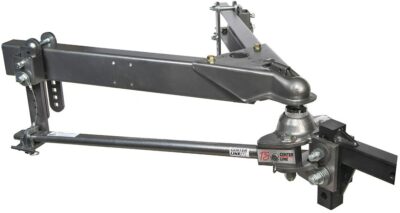
Editor’s Rating:
Quick Facts
- Style: Round bar
- Tongue Weight: 800 lbs.
- Gross Weight: 12,000 lbs.
- Shank Size: 2”
- Ball Size: 2 5/16”
Features
The biggest feature that the Husky Center Line has that other hitches don’t is that the anti-sway is built-in and not a separate unit. That’s awesome because it simplifies the install process and makes the setup cleaner. You won’t have to drill holes in your trailer like you would with the EAZ Lift hitch.
You do lose some of the adjustability with the all in one design. It’s easy to choose the stiffness or turn it off on a standard anti-sway system if the need arises. You won’t get that with the Husky Center Line.
It does come with a handle for adjusting things without bending over, which is unique. It’s not something that would be the deciding factor, but it would be neat if more manufacturers included one.
Our Thoughts
We have three units on our list that have anti-sway properties built into the design. One, the Anderson Hitch, is expensive and complicated, so it’s not really comparable. The other is the 10k RB Fastway hitch, which looks exactly the same as the Husky Center Line from a distance. They even suffer from the same problems, like the lack of adjustability and difficult to remove pins.
The Husky product is just a lot more refined. The washers and bolts are easier to access, the finish is a nice rust-proof coating instead of just paint, and the hinge points are better protected from the elements. Everything about it is just higher quality than the Fastway competitor, making it the better buy.
Pros
- Great quality
- Very clean design
- Easy to install
Cons
- Has less adjustability than other hitches
- Pins can be hard to remove
2. Best Budget Pick: EAZ Lift Elite Kit
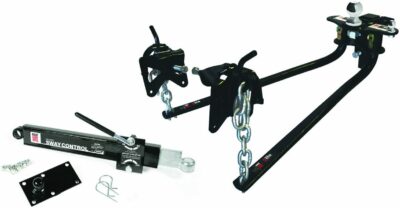
Editor’s Rating:
Quick Facts
- Style: Spring bars
- Tongue Weight: 600, 800, 1000, or 1200 lbs.
- Gross Weight: 10,000, or 12,000 lbs.
- Shank Size: 2”
- Ball Size: 2 5/16”
Features
The EAZ Lift Elite has a lot of great extras. It comes with an anti-sway system that is easy to adjust, it has a decent 2” shank with a 2-5/16 ball pre-installed, and the spring bar design makes it a lower profile than similar round bar systems.
The sway control system can leave you wanting, though. You have to bolt the anti-sway mount to your trailer, which is something that can range from easy to impossible depending on your trailer. Distribution hitches with built-in sway control, like on the Husky Center Line, are better if you have one of those trailers that are hard to work on.
Our Thoughts
There are a few things that make the EAZ Lift stand out, the quality is high, the kit is complete, and you can choose from a variety of different rates. That makes it very likely to work for you.
It’s not perfect. Like we noted before, the anti-sway system can be a bit difficult to install. It also has some problems with fit. Some trailers might have a tongue that is too thick for the chain clamps, and people with lifted trucks might run out of height adjustability with the ball.
However, those problems are not unique to the EAZ Lift. Most weight distribution hitches will have some fitment issues. It’s just worth noting here because there isn’t much to criticize about the EAZ Lift. If you really need something easy to store, you can pay a lot more and get an Anderson hitch, and if you want something easier to install, get the Husky Center Line. If you just want something stout, high-quality, and intuitive, the EAZ Lift is perfect.
Pros
- Good quality
- Includes everything you need
- Inexpensive
Cons
- Anti-sway mount can be difficult to install
- Not good for lifted trucks

Editor’s Rating:
Quick Facts
- Style: Chain
- Tongue Weight: 1,600 lbs.
- Gross Weight: 16,000 lbs.
- Shank Size: 2 ½”
- Ball Size: 2 5/16”
Features
The first and most prominent feature is that it has no springs or bars. It’s just a couple lengths of chain, some clamps, and a hitch. That means unlike the rest of the products on our list, the Andersen Hitch can easily fit into a small box. Oh, and it’s self-adjusting, anti-sway, self-leveling, and you don’t have to take it off to back up the trailer.
With a 2 ½” shank instead of a 2” shank and a GVWR of 16k lbs., it can handle almost any trailer and is nearly indestructible. While that 2 ½” shank won’t fit all trucks, it’s standard equipment if you are towing something that weighs that much.
Our Thoughts
Everything we gush about in the feature system has a steep cost, though. The Andersen Hitch costs hundreds of dollars more than other weight distribution hitches. Even other heavy-duty hitches like the Curt Short Trunnion cost significantly less.
Two scenarios make this Anderson hitch absolutely worth it, though. First, if you value easy to install and work with products, there’s nothing like it. It weighs less than most hitches, it’s ridiculously easy to assemble and attach, and you don’t have to adjust it or remove it each time you go on a drive.
The second reason that it can be worth the price is if you have multiple trailers and want to keep the hitch with your tuck. Since it’s lightweight and doesn’t take up much room, it’s easy to shove into a toolbox when not in use. And since it disconnects with a couple of pins and two bolts, it’s easy to move from trailer to trailer.
Pros
- Very easy to live with
- Heavy-duty
- Indestructible
Cons
- Expensive
- 2 ½” shank won’t fit some vehicles
4. Best For Heavy Trailers: Curt Short Trunnion With Sway Control

Editor’s Rating:
Quick Facts
- Style: Trunnion
- Tongue Weight: 1,500 lbs.
- Gross Weight: 15,000 lbs.
- Shank Size: 2”
- Ball Size: 2 5/16”
Features
The Curt Short Trunnion’s defining feature is its use of trunnion bars instead of round bars or springs. Trunnion is actually the style of attachment joint on the hitch head, but most often it’s just used to refer to the entire bar assembly. What it allows is a much higher strength with much less material. In this case, it’s what gives this Curt hitch it’s massive 1,500 lb. tongue weight capacity that’s only topped by the much more expensive Andersen hitch.
The Curt includes a sway control arm, but it is more difficult to install than the EAZ Lift equivalent, and can be a lot more frustrating to adjust. In fact the entire system is harder to adjust. It has less vertical movement and less tilt than similar hitches.
It makes up for that lack of adjustability with Curt’s unique trailer clamps. Both this unit and the less expensive Curt Round Bar Hitch use a very simple lever lock for clamping onto the trailer’s tongue.
Our Thoughts
This hitch is perfect if you need to tow a heavy trailer and don’t want to pay for the Andersen hitch. The problem is that most people don’t need to tow that much weight. Even a really big travel trailer, like a 38’ Jayco, has a total weight of less than 8000 lbs. That means spending extra money and doing a lot of extra work for capacity that you probably don’t need.
If you do need it, though, the unique lever clamps make it really easy to take on and off. Curt is no slouch when it comes to quality either, so you definitely won’t be disappointed.
Pros
- Easy to put on and take off
- Good for heavy trailers
- Good quality
Cons
- Sway control bar is hard to install
- Lacks adjustability
5. Easiest to Install: Curt MV Round Bar With Sway Control

Editor’s Rating:
Quick Facts
- Style: Round bar
- Tongue Weight: 1,400 lbs.
- Gross Weight: 14,000 lbs.
- Shank Size: 2”
- Ball Size: 2 5/16”
Features
The Curt MV has everything you could want. It’s got a simple sway controller that’s easy to use, the same quick clamps for installation, and a good amount of adjustability. What sets it apart is the price. Nothing else in its price range can handle the same amount of weight.
Our Thoughts
The Curt MV is about as simple as a weight distribution hitch can be. It does what it says it will do, and it doesn’t cost very much. The quality is fine, and it’s easy to attach to the trailer. There’s really nothing to be overly critical about.
It does take extra tools to install the anti-sway bar, and it suffers from the same issues that almost all of the simpler hitches suffer from when it comes to height adjustment. If you have a lifted truck, just buy a different shank. You’ll still save money compared to buying a premium hitch like the Andersen.
Pros
- Inexpensive
- Good for heavier trailers
- Easy to attach
Cons
- Anti-sway bar can be hard to install
- Not good for lifted trucks
6. Best Sway Control: Reese Strait-Line
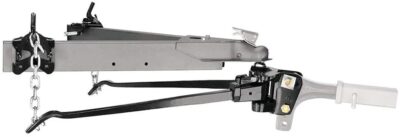
Editor’s Rating:
Quick Facts
- Style: Trunnion
- Tongue Weight: 1,200 lbs.
- Gross Weight: 12,000 lbs.
- Shank Size: N/A
- Ball Size: N/A
Features
The Reese Strait-Line is a trunnion system and won’t cause a lighter trailer to bounce around. Usually, heavy-duty weight distribution hitches meant for heavier trailers will cause the ride quality of lightweight trailers to really suffer, but there is enough adjustability and movement built into the Reese Strait-Line that it’s not an issue.
The other, more significant feature of the Strait-Line, is the advanced sway control. It uses shocks that attach to the trailer and the hitch to keep the trailer traveling the same direction as the tow vehicle. It’s the best anti-sway system on our list, so if you need to travel on many highways, it can’t be beaten.
Our Thoughts
On paper, the Reese Strait-Line is one of the best hitches you can buy. It can support a lot of weight, and the “Dual-Cam” stability system is really incredible.
In practice, it’s a bit harder to justify. The stability system needs to be mounted in a very specific spot and will not work with some trailers. In fact, if you have a trailer frame measuring more than 2 ½” wide, the entire system won’t work.
Couple that with the high price and lack of included shank, and you can end up spending a lot of money on something that won’t work for your situation. If it can work for you, though, you’ll never want to use a cheaper system again.
Pros
- Great for towing long distances
- Is good for a wide range of trailer weights
- Has a lot of adjustability
Cons
- Hard to install
- Very expensive
7. Most Versatile: Fastway e2
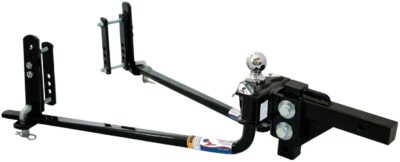
Editor’s Rating:
Quick Facts
- Style: Round Bar
- Tongue Weight: 1,000 lbs.
- Gross Weight: 10,000 lbs.
- Shank Size: 2”
- Ball Size: N/A
Features
The Fastway hitch is both a weight distribution hitch and an anti-sway device in one. That’s great for ease of installation since there’s no extra system to install on your trailer. It also means it’s easier than other systems to drive with since you won’t have to disconnect it to back up or do tight maneuvers.
The thing that really differentiates the Fastway when it comes to features is the amount of customizability that Fastway offers from the factory. You can get it with or without a shank, and with or without a ball. That’s perfect if you have a vehicle or trailer that needs unusual sizes, and you have to source those parts separately. Especially if you have an old caravan with a 1 ⅞” receiver. No one makes a weight distribution hitch that comes with that size ball natively.
Our Thoughts
The customizability is really nice. If you have a lifted truck and are going to be forced into getting an unusual shank anyway, or have trailers that are on the smaller size, then it’s perfect.
If you have a standard setup for towing, though, you would be better off with the Husky Center Line. The quality of the Husky hitch is a lot higher, and it doesn’t cost more. Especially if you don’t have the tools required to install the ball, which should be torqued to 450 lbs. and requires a giant socket. You lose everything that makes the Fastway unique if you have to order it with the ball pre-installed.
Pros
- Highly customizable
- Easy to drive with
- Easy to install
Cons
- Quality could be better
- Requires special tools to utilize
8. Best Basic Weight Distribution Hitch: Reese Wd Rb Pro

Editor’s Rating:
Quick Facts
- Style: Round bar
- Tongue Weight: 1,000 lbs.
- Gross Weight: 10,000 lbs.
- Shank Size: 2”
- Ball Size: 2 5/16”
Features
It’s got an ok sway control arm. That’s about it for features. It costs less than half when compared to some of the alternatives and is the least expensive item on our list. Any of the other products will have more features, and all of them will make towing a trailer easier than the Reese Rb will.
Our Thoughts
The quality isn’t as high as other hitches, and Reese’s quality control isn’t as good either. They have a reputation of being a Walmart brand, so take that how you will. The problem is that Reese has two separate lines. They have a high-quality, super-expensive line of products that include their world-class brake controllers and the heavy-duty Strait-Line hitch. They also have a line that is available at Harbor Freight and Walmart. You can guess which line produces the Wd Rb.
Still, this thing is cheap, and it will level your towing experience. If it’s what you can afford, by all means, get it. You’ll be happy. Just keep some spare lengths of chain and some extra pins handy just in case.
Pros
- Inexpensive
- Has a decent weight rating
Cons
- Quality could be better
- Prone to quality control issues, like missing parts from the factory
In-Depth Guide on Weight Distribution Hitches
Here in this section, we’d like to talk to you about the little nuanced differences between hitches. We’d also love to give you tips and tricks to help you get the most out of towing with one of the products we recommend.
Types of Distribution Hitches
There are four different designs we discuss in our review list. Like we said above, it’s probably not going to be a determining factor in which system you ultimately choose, but we thought it’d be good to know about the different types.
Standard Round Bar
Round bar systems are the least expensive of the main methods. The downside is that they tend to hang down lower than other methods. That can lead to them dragging on the ground, which can cause sparks and damage components. They are easier to adjust, though, since they are simpler than other methods. The Curt MV on our list uses this technology.
Springs
Spring bars are sort of like a cross between trunnions and round bars. They use the same side to side mounting brackets as a trunnion bar, but offer better adjustability like a round bar. They tend to be best for medium-duty applications. They can be used in hitches like the Husky Center Line that combine sway control and weight distribution.
Trunnion Bars
Trunnion bars, like on the Curt Short Trunnion hitch, are best for heavy-duty applications. They have better load dispersal properties and sit higher off the ground than round bars. Technically, trunnion bars are defined by how they attach to the assembly head, but when people talk about them, they are usually referring to the entire bar and clamp system.
Chains and Dampers
There is really only one product that uses this style, and it’s the Andersen Hitch we recommend on our list. The best thing about the chain and damper system is that it can be easily stored since it doesn’t have stiff bars that have to be accommodated. It’s also the easiest to maneuver a trailer with since the dampers can automatically adjust to different conditions. The downside is the cost; they are easily the most expensive method.
Tips and Tricks
To get the most out of your towing experience, we compiled some great tips and tricks.
Make Sure to Adjust Your Hitch Properly
The main adjustment for a weight distribution hitch is the tilt. Tilting the ball back puts more load on the springs, putting more leveling force on the tow vehicle. Curt, who is responsible for manufacturing two of the hitches we recommend, has a great guide on installing and adjusting for best performance.
Make sure to read the manual and take a look online too. Each hitch is different, and the way that they adjust can vary from product to product. It’s especially important to read the manual for the more unusual hitches like the Andersen hitch that uses chains or the Reese hitch with its own special dual-cam design.
Make Sure to Adjust the Anti-Sway Bar Properly Too
An anti-sway device that is too loose can still allow your trailer to sway. If it’s too tight, you may have trouble turning. This how-to article is about travel trailers specifically, but the process is more or less the same.
Disconnect Auxiliary Sway Controllers When Backing Up
Backing up a trailer is a difficult enough task without having an anti-sway bar making it harder. Like the EAZ Lift, on units that come with an auxiliary bar, make sure to turn it off or disconnect it before backing into a spot.
Units that are an all-in-one design like the Husky Center Line shouldn’t have any issues backing up since no extra force is applied to the tongue.
Test Your Trailer Brakes
Improperly adjusted or improperly installed weight distribution hitches can hurt trailer brake performance. Always test it out before hitting the open road, and make sure your brake controller is adjusted properly. Don’t have a brake controller? Don’t worry, we have you covered.
Special note about surge brakes: While most electric trailer brakes will work fine with a properly adjusted hitch, some designs will prevent surge brakes from working. It’s best to do a quick search online about your trailer brakes style to make sure it will work with the style of weight distribution hitch you are considering.
Enjoy the Journey
Towing a trailer can be stressful enough without having to worry about traction and weight problems. With a good weight distribution hitch, you can enjoy the journey to an awesome destination without having to spend the entire drive with a death grip on the wheel stressed out of your gourd. The best part is that other people on the road will feel better about driving with you, and that makes the whole world a better place.
